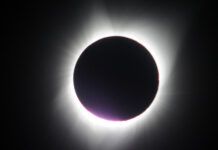If the weather cooperates, South County residents who either stay up late or get up early will have a chance to view a total lunar eclipse during the early morning hours of Saturday, April 4. It will be a bonus for many observing the Easter weekend holiday.
A total lunar eclipse occurs when the moon crosses in front of the earth’s shadow, thus darkening its surface. The earth’s shadow cone is much larger than the moon, though the moon’s orbit is slightly inclined, meaning the moon does not go directly through the largest part of the shadow cone on any one passage.
The moon trends toward the extreme upper limit of the earth’s shadow cone for Saturday’s eclipse, meaning that the total eclipsed phase will only last about five to 12 minutes – the shortest this century.
When the moon passes through the center of the earth’s shadow cone, the total eclipsed phase lasts much longer.
During the last total lunar eclipse visible from Chula Vista, on Oct. 8, 2014, viewers experienced 59 minutes of “totality.” Because the moon was also closer to the center of the earth’s shadow during the October 2014 eclipse, the degree of darkening of the lunar surface due to the earth’s shadow was also deeper.
Total lunar eclipses are also referred to as a “blood moon” due to their often reddish coloring of the lunar surface due to light refracted through the edges of the earth’s atmosphere.
Saturday’s total lunar eclipse is the third in a tetrad (four total lunar eclipses in series). Other eclipses in the tetrad were those of April 15, 2014 and Oct. 8, 2014 and the upcoming one on Sept. 27, 2015.
Greatest eclipse will occur at 5 a.m. PDT.
However, skywatchers will notice a darkening of the moon’s limb starting at 3:16 a.m. when the partial phase begins. The total phase starts at 4:54 a.m. and ends at 5:06 a.m.
The earth’s shadow will then begin to depart the moon’s face, leaving at 6:45 a.m. just after moonset for San Diego County viewers.
The moon will be descending toward the western horizon during all phases of Saturday’s eclipse and will be low in the sky during the total phase, would may present some interesting photographic opportunities with foreground objects such as trees or buildings – or even the beachfront.
Clouds may also present some interesting pairings with the eclipsed or partially-eclipsed moon.
No special viewing apparatus is needed to observe Saturday morning’s eclipse, though binoculars or low-power telescopes may help observers better appreciate the celestial event.
It is safe to point a telescope at the total eclipsed moon.
Photographers may obtain striking images of the event by mounting their cameras on a stable tripod or tracking mount and shooting images at regular intervals to capture various stages of the eclipse.
The full moon, prior to eclipse, will be very bright and will require short exposure times, on the order of 1/1000th of a second with a 200 ISO setting at f/5.6 with a 300mm lens to start. As more of the lunar surface becomes covered by the earth’s shadow, however, exposure times will need to be lengthened as the moon’s overall light output dims.
Exposures between 1-3 seconds may be required near greatest total eclipse. Photographers may also want to increase their ISO settings and reduce the f/stop to values closer to f/2.8 to avoid long exposures that may smear the moon’s image due to its slight (but detectable) motion across the frame of view.
Bracketing around several settings or a combination of settings should produce suitably good results.
Observers should notice the sky to appreciably darken when about 75 percent of the moon is eclipsed. This might be a good time to check out Jupiter and Saturn as well as the new nova in Sagittarrius, which should be in good view in the southern sky after 4:30 a.m.
Though the umbral phase of the eclipse (earth’s dark shadow) starts at 3:16 a.m., the penumbral phase of the eclipse (lighter outer portion of earth’s shadow cone) starts at 2:01 a.m. The penumbral phase causes a slight dip in the brightness of the moon and can often present a pale yellowish coloring to the moon’s disc. Many observers may not even notice it.
However, photographers may notice their settings need to be changed slightly when going from the bright full moon to the penumbral phase.
In deep penumbral eclipse, features start to become a bit more hazy, not quite as sharp as before.
The beginning of the penumbral phase is called first contact (P1) whereas the start of the umbral phase (contact of the earth’s shadow on the moon’s limb) is called second contact (U1). Third contact (U2) is the beginning of the total eclipse, followed by fourth contact (U3), the end of the total eclipse. Fifth contact (U4) is the end of the partial eclipse. Sixth contact (P4) marks the end of the penumbral phase.
The moon will have set prior to sixth contact Saturday morning.
Moonrise is scheduled for 6:44 p.m. on Friday, April 3. The moon will be bright all night long as it traverses the sky toward reaching its exact full phase at 5 a.m. Saturday morning when it will be 250,525 miles from the earth.
The moon will be highest (and presumably brightest) in the sky at 12:44 a.m. Saturday morning.
Moonset is scheduled to occur at 6:40 a.m.
The Star-News will attempt to provide updated images of Saturday’s total lunar eclipse throughout the night, weather permitting.
Sky conditions at sunset included a fair degree of high cloudiness, with morning fog a possibility.
Sky conditions at 11:20 p.m. Friday upgraded to mostly clear with high wind speeds at high altitudes.
Sky conditions at 12:20 a.m. included an increase in high cloudiness, very apparent near the moon as it nears the celestial meridian.















